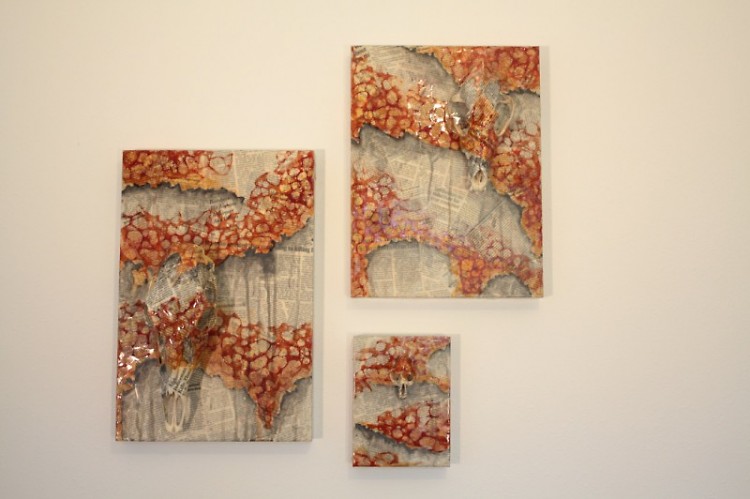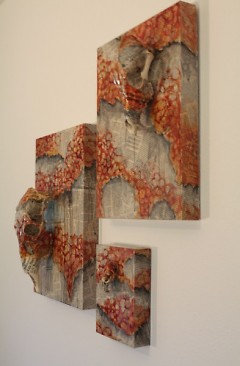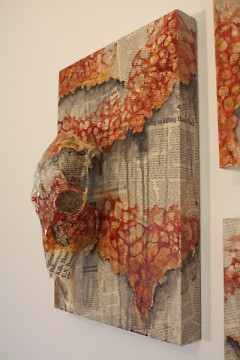Fall is here and so is ArtPrize 2013: nineteen exciting days for Grand Rapids with seasoned and new ArtPrize contestants displaying their work side by side. For some, like Nichole Riley, ArtPrize 2013 will be the first time they display their art in public.
Art, Riley explains, is very personal. It took a loving push to get her to display Enchanted Disregard at GRCC’s Spectrum Theater. “My husband, he’s my biggest support,” Riley says, “he’s my push. I can ask him [about my art] and I’m not hurt [by what he says]. And I don’t have to listen.”
In order to present Enchanted Disregard to the public, however, Riley had to accept that not everyone will appreciate her piece. “First, there was so much time and thought invested into the piece, the trial and error, how the piece culminated into so many meanings." Now, the piece stands as a marker of personal growth and experience. "It feels like putting your personal journal in a public venue. I had to find a zen-like acceptance that allows the piece to stand on its own.”
To Riley, her art pieces are like children. “It’s hard to let them go," she notes, which is not unlike parenting. As her daughter moved into adulthood, Riley had to "accept that she was going to stand on her own, without regard to the work and thought that went into cultivating the adult that was about to venture out on her own.”
And so, Enchanted Disregard, stands on its own for the viewer to examine.
Enchanted Disregard consists of three, three-dimensional canvases. Attached to each canvas is a skull. Riley then covered the skulls and canvases in carefully selected newspaper articles and headlines, using Lazertran transfer paper and turpentine to mold the newspaper to the skulls. Each headline was hand-picked and became a design element, directing the viewer’s eyes.
Riley feels most creative when she is experiencing strong emotions. In fact, her inspiration for Enchanted Disregard came when she stumbled across an animal skull while chaperoning her son and his friends on a golf outing. She ventured into the rough near the edge of the forest and found a small skull, “clean and white by nature,” she recalls. “An animal left the world and no one noticed.”
This unnoticed death caused Riley to reflect upon the struggles and pains of this world. “It was sad. This quiet moment in the woods, nobody was aware of the life that came and went between the whooshing of the trucks or noise of electronics. How much of this ‘little’ life goes unnoticed with today's pace? And why? Why are we moving so much? Why do we make so much? Why do we need so much? That was the beginning.”
The newspaper articles and headlines in her piece present a range of themes from materialism and consumerism to death. Riley remarks, “There are articles that are about typical violence: violence against refugees, children, and wives. There are stories of found bodies and missing people. Stories of hurricanes and oil spills. People in authority who abuse it. Corruption by politicians and school board presidents. There are stories of sisters suing each other over lottery winnings.”
She asks, “How many more of these 'moments' are we, am I, unaware of? If these are a snippet of what is going on in the world... how sad.”
With an art degree and a current position as a high school math teacher, Riley has embraced the struggle of the finite and the whimsical. She explains: Math is a unitary language and art is subjective. Riley says she struggles to let go of control. “I hope we’re all pushing ourselves to our uncomfortable place…that’s where we grow and learn.”
While painting can be controlled through the choice of brush and brush stroke, Riley uses color as an emotional tool. Sometimes you just have to go on instincts when you pick a color. “I think it’s primal,” she says. While the red of Enchanted Disregard could be described as "blood red," that was not her intention. She is naturally drawn to reds and oranges.
Riley is not looking for any particular response. She just wants to get viewers thinking, and hopefully, to expose the psychological effects of consumption and materialism in society. Most people, she feels, have become desensitized to the crime, suffering, and heartache of those around them. Through trying to gain as much wealth as we can, we have neglected to look out for the suffering of those around us.
Riley’s solution to the disregard for human suffering is empathy. “The world around you has a story. Everybody has a back story. We’re all in it together.” To Riley, empathy can make everybody’s day better.
So can art. ArtPrize works its own kind of connection, opening a discussion about what art is. People get to look, talk, and define art for themselves. ArtPrize brings a renewed appreciation for art, and for Riley that appreciation stems from knowing that real, human hands made each art piece, not a machine.
Riley, who works from a studio at the Park Trades Center in Kalamazoo, is a former GRCC student. She’s returning home for ArtPrize, with Enchanted Disregard on display in the lobby of GRCC’s Spectrum Theater.
The Rapidian, a program of the 501(c)3 nonprofit Community Media Center, relies on the community’s support to help cover the cost of training reporters and publishing content.
We need your help.
If each of our readers and content creators who values this community platform help support its creation and maintenance, The Rapidian can continue to educate and facilitate a conversation around issues for years to come.
Please support The Rapidian and make a contribution today.


